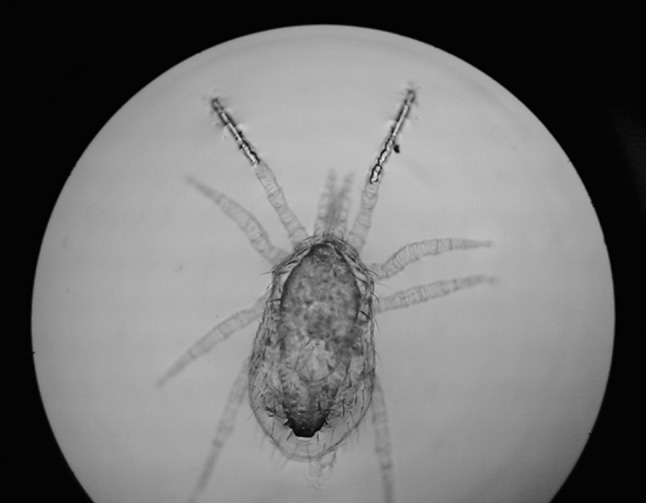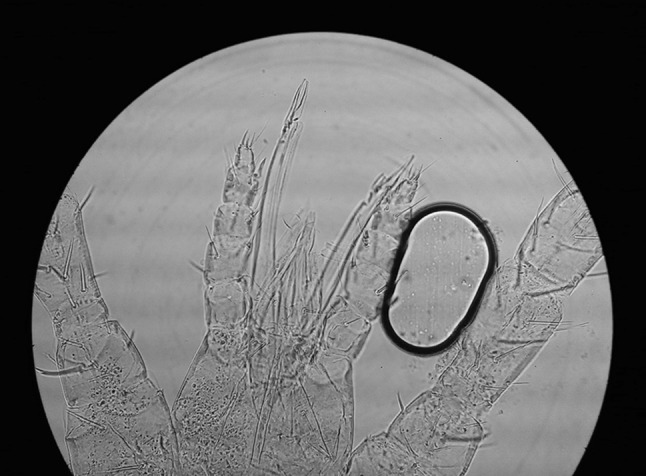Abstract
The common blood feeder mites of poultry are from the genera Dermanyssus and Ornithonyssus. Their presence are problematic for the producers either through potential direct effects on weight gain, egg production or sperm production in roosters or as nuisance pests on workers. They also cause anaemia in birds and play a vector role for several human and animal diseases. Five poultry farm buildings of Vikarabad area of Rangareddy district were visited. Samples were collected from a variety of sites, including beneath feed troughs, inside cage fittings and fastening clips, under egg conveyer belts and under manure belts. Heavily mite infested feathers were plucked from three to five individual birds and kept in closed plastic covers. Samples were processed and mounted permanently by using DPX and species differentiation was done. Besides this litter materials and soil samples from the farm were also collected. Massive mixed infestations of Dermanyssus and Ornithonyssus mites were found. The morphological characters provided here can be considered as a practical tool for species differentiation and as these blood feeder mites were most prevalent and important pests of poultry, public health aspects of these parasites should be considered.
Keywords: Dermanyssus gallinae, Ornithonyssus bursa, Poultry farms, Vikarabad area
Introduction
Among the various ectoparasites of domestic fowl, the mites are of considerable importance despite their small size. The common blood feeder mites are from the genera Dermanyssus (De Geer 1778) and Ornithonyssus. The population can become very high on birds because of their life cycle and their presence are problematic for the producers either through potential direct effects on weight gain, egg production or sperm production in roosters or as nuisance pests on workers, particularly people handling eggs and hens (Hogsette et al. 1991). These mites are responsible for anaemia in birds and play a vector role for several human and animal diseases. Dermanyssus gallinae is the most important poultry ectoparasite affecting laying hens. Poultry houses are often affected by these haematophagous mites Rahbari et al. (2009). The aim of this study was pointing out the status and prevalence of Dermanyssus and Ornithonyssus mites.
Materials and methods
The study was carried out in five breeding and caged layer poultry farms (more than 10,000 birds) in Vikarabad area of Hyderabad, based on complaints of the farmers there is a presence of minute chicken ectoparasites and the nuisance caused by them.
Monitored for presence of mites by collecting samples during daylight hours from a variety of farm habitats, including beneath feed troughs, inside cage fittings and fastening clips, under egg conveyer belts and under manure belts. Mites were collected directly with a fine brush and held in closed plastic covers.
About 50 birds were also selected throughout house and their body surface and vent area were examined under bright light. When large mite populations were encountered in flocks, heavily mite infested feathers were plucked from at least 15 birds. The feathers were placed into plastic covers and then carried to the laboratory to confirm species identification.
Dried litter material and the soil samples were also collected from the beneath of the poultry cage houses. Litter materials were processed by sedimentation technique. The soil samples and the sediments both were subjected for microscopic examination.
The mites were first killed by pouring 10 % NaOH into the plastic covers. They were kept in 10 % NaOH solution for overnight and then clearing was done by keeping the mites for 1–2 days in lactophenol. Then mites were permanently mounted by using DPX. The leftover feather samples were preserved in 10 % formalin. The slides were examined under microscope and identified with the aid of the key developed by Baker (1999) and Antonella et al. (2012).
Results
All inspected caged layer and breeder flock were found to be infested with mites such as D. gallinae and Ornithonyssus bursa. D. gallinae belong to the parasitiformes order Mesostigmata (Gamasida), in the suborder Monogynaspida, superfamily Dermanyssoidea, family Dermanyssidae (Krantz 2009; Figs. 1, 2, 3, 4, 5, 6, 7).
Fig. 1.

Infestation of feathers with mites
Fig. 2.

Mites on the feather follicle (microscopic view)
Fig. 3.

Dorsal shield of O. bursa gradually tapers at posterior
Fig. 4.

Dorsal shield of D. gallinae posterior end
Fig. 5.

Anus at the anterior half of anal plate in O. bursa
Fig. 6.

Anus at the posterior half of the anal plate in D. gallinae
Fig. 7.

Elongated chelicerae with bursa of O. bursa
Ornithonyssus bursa is also a Dermanyssoid mite, but it is placed in the family Macronyssidae. O. bursa can be distinguished from D. gallinae as follows:
The dorsal shield of O. bursa gradually tapers to a blunt posterior end (broadly rounded posteriorly in D. gallinae).
Anus is present on the anterior half of anal plate (on posterior half of anal plate in D. gallinae).
The chelicerae of females are elongate but with well developed and distinct fixed and movable digits (whip like with no evident chela in D. Gallinae).
Although the tropical fowl mite (O. bursa) is similar to the northern fowl mite (O. sylviarum), it can be separated by the dorsal plate. The posterior end tapers acutely in O. sylviarum but more evenly in O. bursa. Besides mites, the litter materials were found positive for larvae of soil nematodes, eggs of Capillaria species and mite eggs were also found in the soil samples.
Discussion
Dermanyssus gallinae currently is the most important ectoparasite affecting egg layers in temperate and tropical countries, whereas, O. bursa is distributed throughout the warmer regions of the world (Lancaster and Meisch 1986). The bite of haematophagous mites is irritating to man and some individuals react to the bite with prolonged itching and painful dermatitis (Burtt et al. 1991). Besides having direct effects upon their hosts, poultry mites can transmit viral, rickettsial and protozoan diseases among birds (Kettle 1995. D. gallinae has been recently reported to be an experimental vector of salmonella enteritidis (Valiente et al. 2005). It is also a vector of equine encephalitis virus among poultry (Durden 1993). Several authors showed its relationship to different poultry pathogens such as avian borreliosis, chicken pox virus, Newcastle virus, agent of pullorum disease and fowl typhoid and the agent of fowl cholera (Zeman et al. 1982). O. bursa can spread disease even if each mite bites only a single host. This is because some disease—causing pathogens, such as avian borreliosis, can be passed vertically from a female mite to her offspring (Bowman 1995).
Conclusion
The morphological characters provided here can be considered as a practical tool for species differentiation and as these blood feeder mites were most prevalent and important pests of poultry, public health aspects of these parasites should be considered.
Acknowledgments
We thank the owner of poultry farm and all other farmers for the valuable assistance of providing the specimens and Associate Dean, College of Veterinary Science, Rajendra Nagar, Hyderabad for his cooperation regarding this work.
Footnotes
G. S. Sreenivasa Murthy—Assistant Professor (Senior Grade) & Head.
References
- Antonella DP, Annunziata G, Maria AC, Giacinto SG. A gallery of the key characters to ease identification of Dermanyssus gallinae (Acari: Gamasida: Dermanyssidae) and allow differentiation from Ornithonyssus sylviarum (Acari: Gamassida: Macronyssidae) Parasites Vectors. 2012;5(104):1–10. doi: 10.1186/1756-3305-5-104. [DOI] [PMC free article] [PubMed] [Google Scholar]
- Baker AS. Mites and ticks of domestic animals: an identification guide and information source. London: British Natural History Museum; 1999. [Google Scholar]
- Bowman DD. Parasitology for veterinarians. 6. Philadelphia: W.B Saunders; 1995. [Google Scholar]
- Burtt JH, Chow W, Babbitt GA. Occurrence and demography of mites of tree swallow, house wren, and eastern bluebird nests. In: Loye JE, Zuk M, editors. Bird-parasite interactions. Oxford: Oxford University Press; 1991. pp. 104–122. [Google Scholar]
- Durden LA. Laboratory transmission of equine encephalomyelitis virus to chickens. Med Entomol. 1993;30:281–285. doi: 10.1093/jmedent/30.1.281. [DOI] [PubMed] [Google Scholar]
- Hogsette JA, Butler JF, Miller WV, Hall D. Ornithonyssus sylviarum (Canestriniand Fanzago) (Acari: Macronyssidae) Misc Publ Entomol Soc Am. 1991;76:1–62. [Google Scholar]
- Jl Lancaster, Meisch MV. Arthropods in livestock and poultry production. New York: Wiley; 1986. [Google Scholar]
- Kettle DS. Medical and veterinary entomology. 2. Wallingford: CAB International; 1995. [Google Scholar]
- Krantz GW, Walter DE (eds) (2009) A manual of acarology, 3rd edn. Texas Tech University Press, Lubbock
- Rahbari S, Nabian S, Ronaghi H. Haematophagous mites in poultry farms of Iran. Iran J Arthropod-Borne Dis. 2009;3(2):18–21. [PMC free article] [PubMed] [Google Scholar]
- Valiente C, Shauve C, Zenner L. Vectorial role of some dermanyssoid mites (Acari, Mesostigmata, Dermanyssoidea) Parasite. 2005;12(2):99–109. doi: 10.1051/parasite/2005122099. [DOI] [PubMed] [Google Scholar]
- Zeman P, Stika V, Skalka B, Bartik M, Dusbabek F, Lavickova M. Potential role of Dermanyssus gallinae (De Geer, 1778) in the circulation of the agent of the agent of pullurosis-typhus in hens. Folia Parasite. 1982;29:371–374. [PubMed] [Google Scholar]


